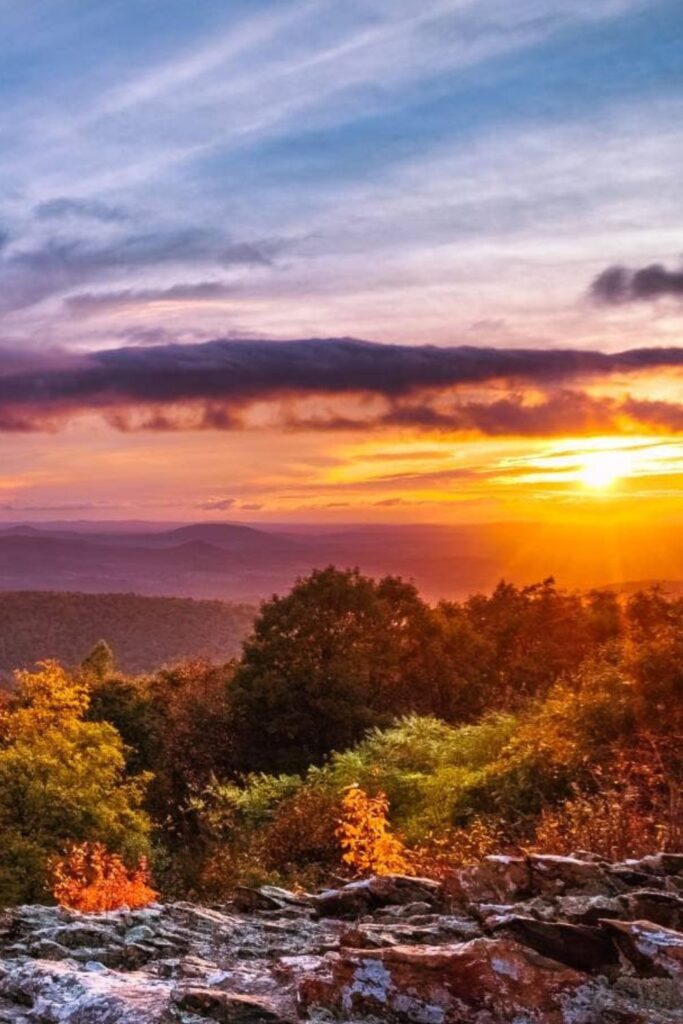
Fun and Exciting Things to Do Shenandoah National Park
We may earn money or products from the companies mentioned in this post.
Shenandoah National Park is a national park administered by the US National Park Service, covering an area of 310 square miles, located near the small town of Front Royal, built on the ridges of the Blue Ridge Mountains in the United States of America, Virginia.

This national parkland is narrow and long. Therefore, it contains portions of 8 counties of the state of Virginia. To the west are the broad Shenandoah River and the Shenandoah Valley, and to the east are the rolling hills of the Virginia Piedmont region. The highest elevation in this mountain range is Hawksbill Mountain with an altitude of 4035 ft. This narrow hilly land is covered with deciduous groves and forests. The narrow national park has scenic highways and an important walking path.
The best known of these is the 105 miles long scenic road called “Skyline Scenic Highway”. This road is a land route built exclusively for this national park, passing through the peaks of the “Blue Ridge Mountains”, part of the Appalachian Mountains, and allowing easy views of the valleys.
This scenic road attracts a huge number of visitors with motor vehicles when they fill the peaks and hills, which are filled with trees that prepare to shed their leaves in the autumn season and change their colors from green to orange and then yellow. It is estimated that the annual number of visitors to this park for the “Skyline Scenic Highway” exceeds 2 million.
Next to this scenic highway is the “Blue Ridge Parkway”, which follows an almost similar route. This road is 470 miles. It starts from Great Smoky Mountains National Park in the south, passes north into Shenandoah National Park, and finally meets the Skyline Drive end near the end of this park. The primary goal of this road is to connect two popular national parks in the eastern United States.
A similar route is traversed by the much longer Appalachian Trail, a long-distance hiking trail that begins at Springer Mountain in Georgia and ends at Katahdin Mountain in Maine. This path, like the scenic highways, enters from a narrow side of the Shenandoah National Park in the south-north direction, passes its length in scenic parklands, and exits from the other narrow side of the park.
While Shenandoah National Park meets the demand of visitors who want to pass through scenic lands and be one with nature, either by motor vehicle or on foot, there are other hiking paths in this national park that total 500 miles. In addition, 40% of this park’s land is part of the National Wildlands Conservation System, for which it has a special conservation status and is the target of stricter conservation regimes.

Moreover, this national park also has horse riding trails and bike trails. There are also 10 waterfalls in the park that attract visitors.
The US national park Shenandoah National Park covers about 500 square miles of the Blue Ridge Mountains in the southern Appalachian Mountains near the Piedmont Plateau in Virginia. It is a narrow corridor of densely wooded ridges and forests with numerous rivers and waterfalls with a wide valley on each side. The highest peaks, Stony Man and Hawksbill are over 400 ft high.
Nature

Mammals include white-tailed deer, American black bear, bobcat, raccoon, skunk, northern opossum, red and gray fox, and Florida cottontail. Over 200 species of birds live in the park, of which around 30 species winter here. 32 species of fish live in the waters of the park.
The tree population consists of oak, hickory, chestnut, and willow. The American chestnut, which once dominated here, was attacked by chestnut blight in the early 20th century and was threatened with extinction for a long time. Although the tree continues to grow after the fungal attack, it dies before it bears fruit for the first time. Various species of oak trees have subsequently replaced the chestnut and become the dominant tree species in the park.
In the 1990s, the oak forests were then infested by the caterpillars of the gypsy moth, which has since decimated the forest stock in the national park by almost 10 percent. Especially in the north of the park, large areas with leafless trees are evidence of this infestation.
Shenandoah National Park Vacation
Shenandoah National Park is easy to navigate. There is one road that runs north-south through the park, called Skyline Drive. It is possible to enjoy the park without even getting out of the car, as Skyline Drive offers a 105-mile scenic view. But of course, nature is meant to be delved into, and explored. Coming from Washington DC, the easiest entrance is at the Thornton Gap entrance station, about three-quarters of the way up the park.
Virginia Hiking
From the Thornton Gap entrance station, the vehicle fee in all months but December through February is $30. The two closest areas to set up camp are Matthew’s Arm to the North and Skyland to the South. From these main hubs, many trails that reach overlooks, springs, and the highest peaks in the park can be found. Some trails will find the remains of villages that existed before the land became a national park. Most of the buildings are not kept up, and some have experienced fires, leaving an eerie past that is incredible to observe.
Camping in Shenandoah
There are three different options for spending the night at Shenandoah National Park. There are three different lodges, which offer permanent housing, and other amenities like restaurants. They are the Skyland Resort, Big Meadows, and Lewis Mountain Cabins. Prices for these lodges range from just over $100 to about $200 for three nights. There are many package deals that also offer $50 meal vouchers.
For those who want to be a bit more outdoors, but still have access to a toilet, the park offers campsites. There are five different campgrounds:
Mathews Arm Campground
Big Meadows Campground
Lewis Mountain Campground
Loft Mountain Campground
Dundo Group Campground.Anyone can be one with nature in Shenandoah National Park by going backcountry camping. This offers an opportunity to get away from other people and find a spot almost anywhere in the park to camp. There are plenty of open areas to set up a tent. All the camper needs is a permit, which is free, and a quick lesson from a park ranger. The key idea to keep in mind is to leave the park as it is.
Don’t take or leave anything. Hang all food in a bag over a tall branch so it is not accessible to bears. There are many other campers, especially during the summer months, but peace can be found by venturing slightly off the trail. The park rangers have good suggestions for all the trails.
Shenandoah offers beautiful scenery with pleasant weather. It attracts many visitors, but plenty of quiet and nature can be found.
